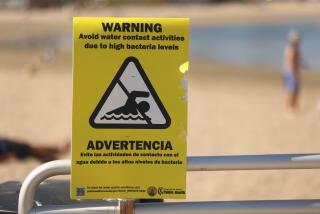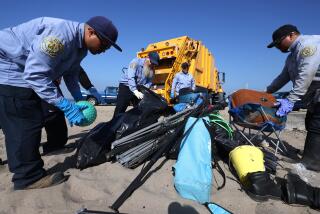Contamination Signs Removed From Part of Beach
HUNTINGTON BEACH — The Orange County Health Care Agency Thursday cut by 60% the coastal area where signs warning of contaminated water were posted.
But officials continued to advise people to stay out of the remaining 40%--about 4,000 feet of ocean. There were no predictions on when the remaining signs would come down.
Richard Bernard, a spokesman for Huntington Beach, said preliminary studies show that enterococcus bacteria that is the cause of the contamination could be coming from the Talbert Marsh and the Santa Ana River.
The results of the studies are undergoing scientific review. Monica Mazur, a county environmental health specialist, said that in addition to the marsh and the river, researchers are looking at the ocean soil and the beach sand as potential sources of contamination.
“Researchers are putting data together and sharing information so they understand the big picture,” she said.
Organizers of a pro surfing competition set to start Wednesday near the Huntington Beach pier, just north of the original contamination area, said they were prepared in case they needed to move the event.
The Bluetorch Pro competition is one of two World Championship Tour stops in the mainland United States.
Ian Cairns, a vice president of Broadband Interactive Group, event coordinator, said organizers were looking at beaches in south Orange County and Los Angeles and San Diego counties if the contamination spreads. The pier is about a mile from the contamination area.
However, he did not expect that to happen. “We’re getting way in front of ourselves,” Cairns said. “I’m not an alarmist. I’m an optimist.”
If the contamination reached the pier, the event could be postponed until the water cleared or “you pick up your clipboard and take your surfers and go up the beach,” he said.
Last summer about four miles of the beach was fouled for more than two months, putting a severe financial crimp on businesses that rely on beach tourism. Huntington State Beach alone saw a drop of at least $250,000 in revenue, state officials said.
As a result of that closing, city and county officials are spending nearly $1 million to divert 2.5 million gallons of runoff a day away from the coastline to a sewage treatment plant.
Urban runoff, which is suspected of causing the contamination, results from such sources as animal feces, fertilizers and the flushing of many of the products of modern life into storm drains and into the ocean.
“Urban runoff is going to be solved when all of us who live within 50 miles of the beach steward our coastal environment better,” said Chris Evans, executive director of the Surfrider Foundation.
More to Read
Sign up for Essential California
The most important California stories and recommendations in your inbox every morning.
You may occasionally receive promotional content from the Los Angeles Times.











